Chapters

Definition
The exponential function is one that assigns to each real value  the power
the power  with
with  and
and  . This function is expressed as
. This function is expressed as

The number  is called the base.
is called the base.
Graphs of Exponential Functions
Let's study the behavior of the exponential function according to its base
We construct a value table for  :
:
 |  |
|---|---|
| -3 | 1/8 |
| -2 | 1/4 |
| -1 | 1/2 |
| 0 | 1 |
| 1 | 2 |
| 2 | 4 |
| 3 | 8 |
We draw the graph
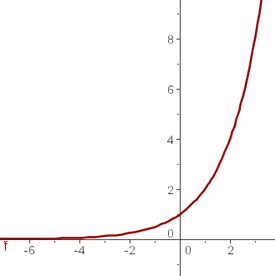
Now we construct a value table for  :
:
 |  |
|---|---|
| -3 | 8 |
| -2 | 4 |
| -1 | 2 |
| 0 | 1 |
| 1 | 1/2 |
| 2 | 1/4 |
| 3 | 1/8 |
We draw the graph
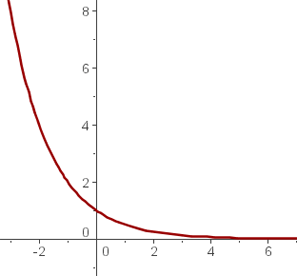
We observe that the first function is strictly increasing, while the second is strictly decreasing; furthermore both are symmetric with respect to the  axis.
axis.
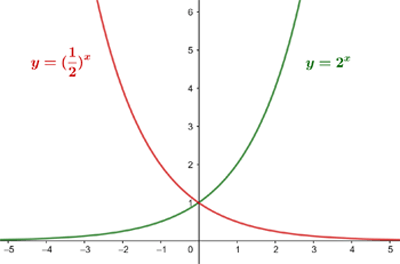
Natural Exponential Function
This is denoted by  where
where  is given by
is given by

This notation was introduced by Leonhard Euler around 1730, when discovering many properties of this number. The number  is irrational and its first ten decimal digits are
is irrational and its first ten decimal digits are  .
.
Properties of the Exponential Function
1 Domain:  .
.
2 Range:  .
.
3 It is continuous.
4 The points  and
and  belong to the graph.
belong to the graph.
5 It is injective  (no image has more than one preimage).
(no image has more than one preimage).
6 Increasing if  .
.
7 Decreasing if  .
.
8 The curves  and
and  are symmetric with respect to the
are symmetric with respect to the  axis.
axis.
9 The exponential function  , with
, with  eventually grows faster than the power function
eventually grows faster than the power function  for any
for any  .
.
10 The inverse function of the exponential function  is
is  . The inverse function of the natural exponential is
. The inverse function of the natural exponential is  .
.
Applications of the Exponential Function
Exponential functions are used to model a wide variety of phenomena such as population growth and interest rates.
Exponential Growth and Decay
The formula used to model population growth is given by

The function  grows exponentially and represents the population quantity at time
grows exponentially and represents the population quantity at time  ;
;  represents the growth or decay constant; if
represents the growth or decay constant; if  it is called the growth constant, while if
it is called the growth constant, while if  it is called the decay constant.
it is called the decay constant.  represents the initial population at time zero, that is,
represents the initial population at time zero, that is,  .
.
The above formula is expressed in terms of the natural exponential, but sometimes it is expressed with base  , this is simple to obtain, just apply the properties of exponents to
, this is simple to obtain, just apply the properties of exponents to  and consider
and consider  to obtain:
to obtain:

Example: A group of researchers study a bacterial culture. If at the beginning of the observation they have  bacteria and half an hour later they have
bacteria and half an hour later they have  , find:
, find:
1 The number of bacteria after two hours.
2 The number of bacteria after three hours.
3 The average rate of change of the population during the second hour.
4 The time required to double the initial population.
5 When will the population equal  ?
?
To be able to answer what is requested, we first need to know the population growth formula  with
with  expressed in minutes.
expressed in minutes.
We note that we know the initial population  , but we lack the value of the growth constant. To find the value of
, but we lack the value of the growth constant. To find the value of  we use the problem data:
we use the problem data:  in the growth formula:
in the growth formula:

Dividing both sides by  and applying the inverse function of the natural exponential, we obtain:
and applying the inverse function of the natural exponential, we obtain:

Thus the function that models the growth of the bacterial population is:

1 The number of bacteria after two hours is:

2 The number of bacteria after three hours:

3 The average rate of change of the population during the second hour
During the second hour, from time  to
to  , the population changed by
, the population changed by  , so the average rate in this time period is:
, so the average rate in this time period is:
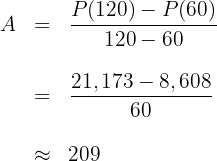
The population increases at an approximate average rate of  bacteria per minute during the second hour.
bacteria per minute during the second hour.
4 The time required to double the initial population
For this we use the following equality

Dividing both sides by  and applying the inverse function of the natural exponential, we obtain
and applying the inverse function of the natural exponential, we obtain

Thus the time required for the bacterial population to double is  minutes.
minutes.
5 When will the population equal  ?
?
For this we use the following equality

Dividing both sides by  and applying the inverse function of the natural exponential, we obtain
and applying the inverse function of the natural exponential, we obtain
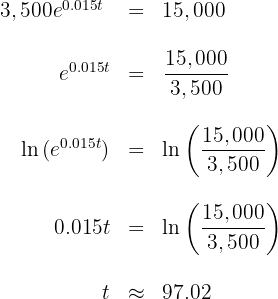
Thus the time required for the bacterial population to be  is
is  minutes.
minutes.
Compound Interest
An initial amount of money  is invested at an interest rate
is invested at an interest rate  expressed in decimals. If the interest is compounded only once, then the balance to obtain
expressed in decimals. If the interest is compounded only once, then the balance to obtain  after adding the interest is:
after adding the interest is:

If the interest is compounded more than once, the interest that is added to the account during one period will earn interest during the following periods. If the annual interest rate is  and the interest is compounded
and the interest is compounded  times per year, then at the end of
times per year, then at the end of  years, the interest was compounded
years, the interest was compounded  times and the balance called future value is:
times and the balance called future value is:

Example: If $500 is invested at a rate of 5% annually. Find the future value after 3 years if the interest is compounded quarterly.
To find the future value after 3 years if the interest is compounded quarterly, we use  .
.
We substitute the values in the future value formula:

The balance obtained  years is
years is 
Continuously Compounded Interest
To know the balance of an investment at the end of  years when the compounding frequency increases without limit, that is, the interest is not compounded quarterly, nor monthly, nor daily, but continuously, the formula is used
years when the compounding frequency increases without limit, that is, the interest is not compounded quarterly, nor monthly, nor daily, but continuously, the formula is used

Example: If  is invested at a rate of
is invested at a rate of  annually. Find the future value after 3 years if the interest is compounded continuously.
annually. Find the future value after 3 years if the interest is compounded continuously.
To find the future value after  years if the interest is compounded continuously, we use
years if the interest is compounded continuously, we use  .
.
We substitute the values in the future value formula:

The balance obtained after  years is
years is  and is the upper limit for the possible balance.
and is the upper limit for the possible balance.












